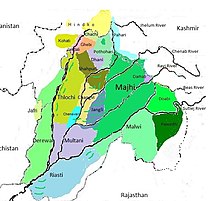
Back പഞ്ചാബി ഭാഷാഭേദങ്ങൾ Malayalam ਪੰਜਾਬੀ ਲਹਿਜੇ Punjabi پنجابی پڑبولیاں PNB पञ्जाबीभाषाः उपभाषाः च Sanskrit پنجابي جا لھجا Sindhi Punjabi dialects and languages SIMPLE பஞ்சாபி கிளைமொழிகள் Tamil పంజాబీ మాండలికాలు Tegulu پنجابی کے لہجے Urdu
| Punjabi languages | |
|---|---|
| Ethnicity | Punjabis |
| Geographic distribution | Punjab, Jammu and Kashmir, Khyber Pakhtunkhwa, Delhi, Haryana, Rajasthan and Himachal Pradesh |
| Linguistic classification | Indo-European
|
Early form | |
| Glottolog | lahn1241 |
| Part of a series on |
| Punjabis |
|---|
 |
 Punjab portal |

The Punjabi dialects and languages or Greater Punjabi are a series of dialects and languages spoken around the Punjab region of Pakistan and India with varying degrees of official recognition.[7] They have sometimes been referred to as the Greater Punjabi macrolanguage.[8] Punjabi may also be considered as a pluricentric language with more than one standard variety.[9]
Punjabi is a language spoken primarily in the Punjab region, which is divided between India and Pakistan. It is also spoken by Punjabi diaspora communities around the world. Punjabi itself has several dialects that can vary based on geographical, cultural, and historical factors.
The varieties of "Greater Punjabi" have a number of characteristics in common, for example the preservation of the Prakrit double consonants in stressed syllables.[10] Nevertheless, there is disagreement on whether they form part of a single language group, with some proposed classifications placing them all within the Northwestern zone of Indo-Aryan, while others reserving this only for the western varieties, and assigning the eastern ones to the Central zone alongside Hindi.[11]
- ^ Haldar, Gopal (2000). Languages of India. New Delhi: National Book Trust, India. p. 149. ISBN 9788123729367.
The age of Old Punjabi: up to 1600 A.D. […] It is said that evidence of Old Punjabi can be found in the Granth Sahib.
- ^ Bhatia, Tej K. (2013). Punjabi: A Cognitive-Descriptive Grammar (Reprint ed.). London: Routledge. p. XXV. ISBN 9781136894602.
As an independent language Punjabi has gone through the following three stages of development: Old Punjabi (10th to 16th century). Medieval Punjabi (16th to 19th century), and Modern Punjabi (19th century to Present).
- ^ Christopher Shackle; Arvind Mandair (2013). "0.2.1 – Form". Teachings of the Sikh Gurus : selections from the Scriptures (First ed.). Abingdon, Oxon: Routledge. ISBN 9781136451089.
Surpassing them all in the frequent subtlety of his linguistic choices, including the use of dialect forms as well as of frequent loanwords from Sanskrit and Persian, Guru Nanak combined this poetic language of the Sants with his native Old Punjabi. It is this mixture of Old Punjabi and old Hindi which constitutes the core idiom of all the earlier Gurus.
- ^ Frawley, William (2003). International encyclopedia of linguistics (2nd ed.). Oxford: Oxford University Press. p. 423. ISBN 9780195139778.
- ^ Austin, Peter (2008). One thousand languages : living, endangered, and lost. Berkeley: University of California Press. p. 115. ISBN 9780520255609.
- ^ Braj B. Kachru; Yamuna Kachru; S. N. Sridhar (2008). Language in South Asia. Cambridge University Press. p. 411. ISBN 9781139465502.
- ^ "Glottolog 4.8 - Greater Panjabic". glottolog.org. Retrieved 2023-07-13.
- ^ For the use of the term "Greater Panjabi", see Rensch (1992, p. 87) and Rahman (1996, p. 175).
- ^ [1]Muhr, Rudoplh (2016) Pluricentric Languages and Non-Dominant Varieties Worldwide. Peter Lang
- ^ Shackle 2003, p. 591.
- ^ Masica 1991, pp. 446–63.